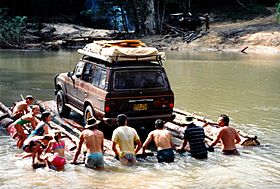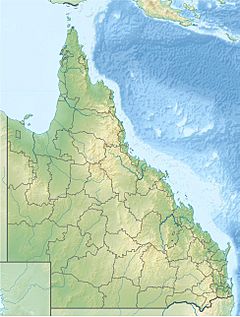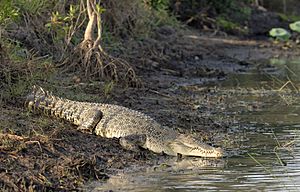Wenlock River facts for kids
Quick facts for kids Wenlock |
|
|---|---|

Crossing the Wenlock River on a makeshift vehicle raft in Wet Season, 1990. This was the only safe way to cross the river until the installation of a bridge in 2001.
|
|
|
Location of the Wenlock River mouth in Queensland
|
|
| Country | Australia |
| State | Queensland |
| Region | Far North Queensland |
| Physical characteristics | |
| Main source | Great Dividing Range below Jacks Knob 215 m (705 ft) |
| River mouth | Port Musgrave, Gulf of Carpentaria Mapoon 0 m (0 ft) 12°00′54″S 141°55′50″E / 12.01500°S 141.93056°E |
| Length | 322 km (200 mi) |
| Basin features | |
| Basin size | 7,526 km2 (2,906 sq mi) |
| Waterfall | Wenlock Falls |
The Wenlock River is an important river in Far North Queensland, Australia. It flows through the beautiful Cape York Peninsula. This river is known for its amazing wildlife and natural beauty.
Contents
Where Does the Wenlock River Flow?
The Wenlock River starts high up in the Great Dividing Range. This is a big mountain range in Australia. It begins near a spot called Jacks Knob. From there, the river flows mostly towards the north-west.
It travels through wide, grassy plains and wetlands. Along its journey, 15 smaller streams join the Wenlock River. Eventually, it reaches the western side of the peninsula. Here, it meets the Ducie River at a place called Port Musgrave. This is just north of Mapoon.
Finally, the Wenlock River empties into the Gulf of Carpentaria. The river drops about 215 meters (705 feet) from its start to its end. It travels a total distance of 322 kilometers (200 miles). The area of land that drains into the Wenlock River is about 7,526 square kilometers (2,906 square miles).
A Special "Wild River"
There are no big dams or structures built on the Wenlock River. Also, not many people live along its banks. This means the river is very natural and untouched. In 2010, the Queensland Government called it a 'wild river'.
This means it's one of 13 rivers in Queensland that are still free. They don't have dams, weirs, or big irrigation projects. They also don't have much industrial development. This helps keep the river healthy and natural.
Amazing Animals and Plants
Much of the Wenlock River is lined with thick rainforests. These forests are like green tunnels along the river. They provide a home for many different animals. You might find the white-tailed rat or the spotted cuscus here. The beautiful palm cockatoo also lives in these trees.
During the wet season, the river gets very full and floods. This water spreads out and helps to fill the wetlands. These wetlands are important for many plants and animals.
Fish Diversity
The Wenlock River is famous for its fish! It has the most types of freshwater fish of any river in Australia. There are about 48 different species. Many of these fish are also found in rivers in southern New Guinea.
Some unique fish include the Buffon's river garfish and the fimbriate gudgeon. You can also find the freshwater sawfish, which is a very special type of fish. More common fish like the sooty grunter, saratoga, and barramundi also live here.
Saltwater Crocodiles
The river is also home to a very large number of saltwater crocodiles. It's one of Queensland's biggest breeding grounds for them. These powerful reptiles thrive in the river's waters.
How the River Got Its Name
The Wenlock River wasn't always called that. It was first known as the Batavia River. But in 1939, its name was changed. It was renamed to honor Baron Wenlock. He was an important person from England.



